ASUS A88X-Pro Review: Kaveri, Kaveri, Quite Contrary
by Ian Cutress on April 22, 2014 11:59 AM EST- Posted in
- Motherboards
- AMD
- Asus
- Kaveri
ASUS A88X-Pro Software
The idea behind manufacturer based OS software is multi-faceted: it has to provide the options similar to the BIOS but in an easier to use way. Because the manufacturer now has the full scope of graphical prowess that is afforded by the operating system, it has to look good and work smoothly. The more features a motherboard manufacturer decides to add to their software stack, the more effort has to go in to developing and testing the visuals around such options. ASUS’ software goes by the AI Suite name, and has been attached to ASUS software for several generations. The latest incantation, AI Suite III, came to pass during the Z87 release and moved to a Java based platform rather than Flash.
ASUS’ software revolves around their Dual Intelligent Processors 4 platform. This is the combination of the TPU and EPU alongside the fan controls and digital power delivery to create ‘4-Way Optimization’:
From this initial screen the user can see the CPU sensors, the fan profiles, the CPU power and choose from several presets for energy conserving or performance. The button on the left offers an automatic test based on environment and usage – it will go through each of the four ways in turn (TPU, EPU, Digi+ Power, Fans) and attempt to optimize for temperature, CPU frequency and power consumption. As a result, we get something like this:
Each of the four sections can also be manually configured. For CPU overclocks, the TPU menu offers frequency and voltage adjustments:
The EPU menu gives each of the four presets on the front page (Auto, High Performance, Max Power Saving, Away Mode) and allows users to adjust features like time-to-sleep or aggressive power saving.
DIGI+ Power Control offers access to the load line calibrations for the system and improving the headroom of the power delivery above defaults. Fan Xpert 2 allows users to test fans to find how RPM varies with power applied and then implement this into the fan profiles:
There are also several presets for fans, including Silent, Turbo and Full Speed. Users can ask the system to probe the fans power response and update the fan profiles automatically.
Slightly hidden away from the initial screen are the rest of AI Suite’s functions. By clicking the icon on the top navigation bar, next to the question mark, we get access to AI Charger+, USB 3.0 Boost, EZ Update, Network iControl, System Information, USB BIOS Flashback, USB Charger+ and Remote Go!. We have covered these features in previous reviews, but here is a brief overview:
AI Charger+: Quick Charging of BC1.1 compliant devices
USB 3.0 Boost: Offers an additional speed for Windows 7 USB 3.0 devices by implementing an updated driver on-the-fly.
EZ Update: Software to allow updates to the system, primarily drivers, software and BIOS. I can now confirm that it works and offers updates.
Network iControl: Software implementation for network data prioritization.
USB BIOS Flashback: Converts the appropriate BIOS to the correct format for USB BIOS Flashback.
USB Charger+: Quick charging of a single device via USB 3.0 by disabling data transfer and increasing power delivery.
Remote Go!: Home cloud computing for media, files, remote desktop and so on.


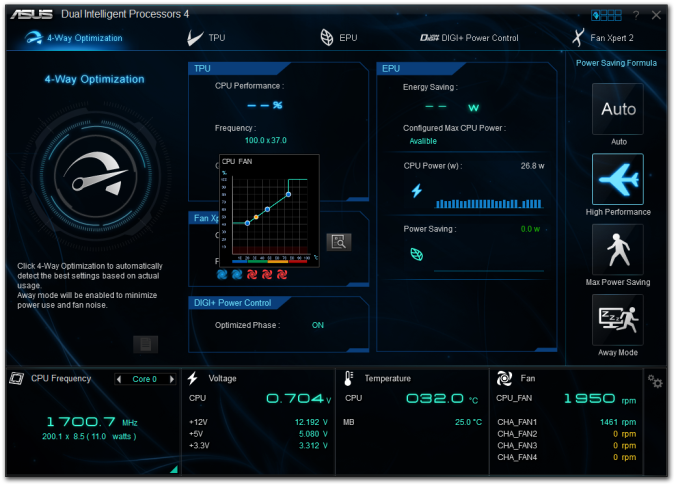
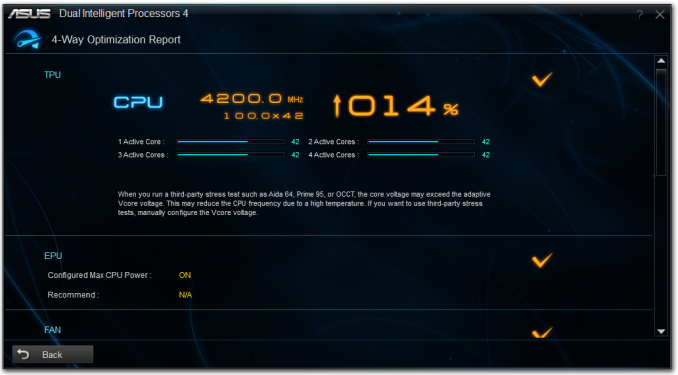
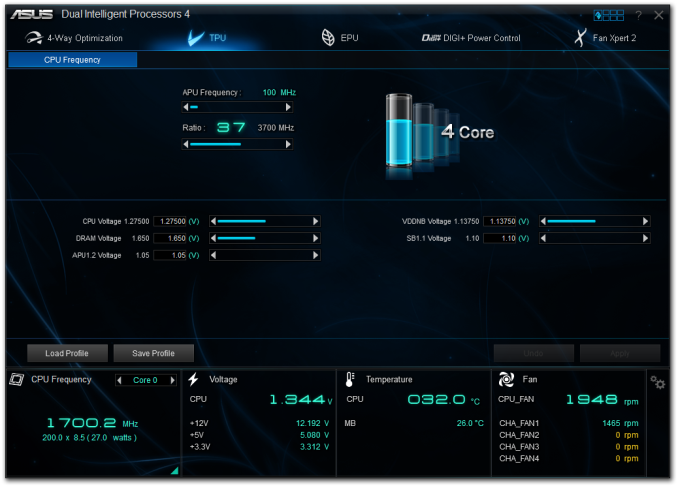
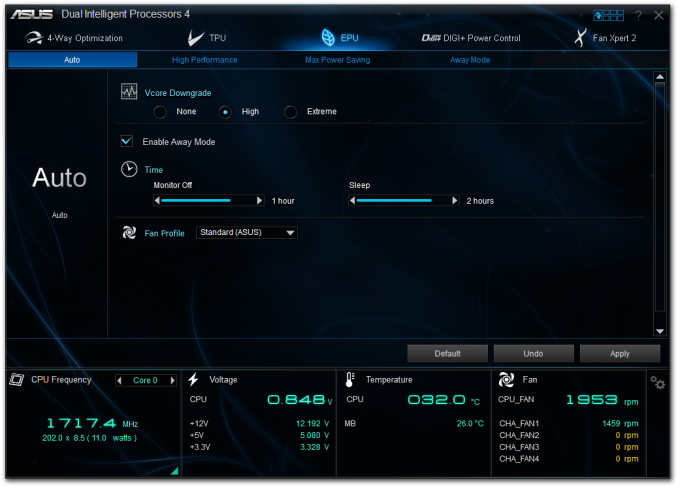
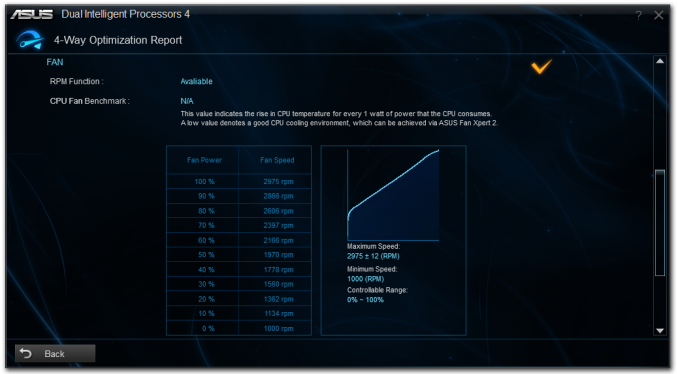
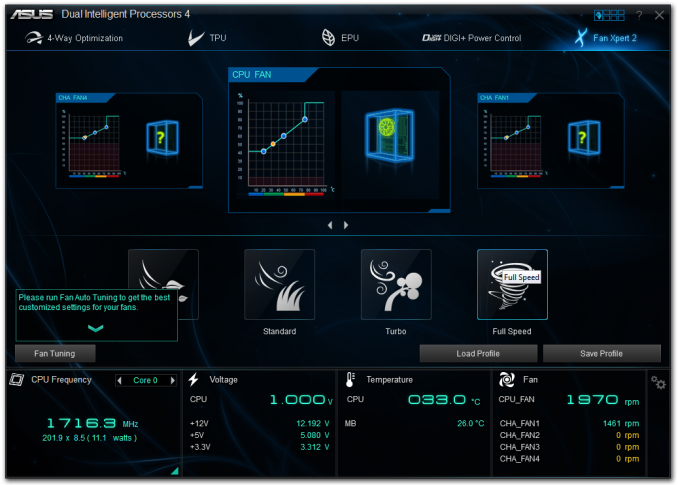














34 Comments
View All Comments
Ortanon - Tuesday, April 22, 2014 - link
EXACTLY. I've been scratching my head on this one. The only possible argument would be that you can cram more gaming into a smaller case, but that's an idiotic argument because 1) who the hell is so desperate to fit a system down to the millimeter and 2) the real-life difference between mini-ITX and micro-ATX cases is often one or two inches in any given dimension.So ultimately Kaveri is, unfortunately, a bust. A moot point. A waste of precious R&D resources. And it's such a shame.
On the bright side, all they'd have to do is adjust the price point. A lot.
Topweasel - Tuesday, April 22, 2014 - link
Obviously you haven't tried to build a computer in SG05 or Ncase M1. Not every ITX case is Prodigy or 250D. Most are much much much smaller in all dimensions than most mATX cases. I would say it's more of the ATX vs mATX that's always bothered me. More often than not an mATX case isn't much smaller than a well spaced full ATX mid tower.That said this motherboard is about as useless as one could be. I see why they are doing it. They want full sized full featured ATX boards for the AMD platform, but with AMD almost completely shutting down AM3+ developments, the future of AMD's platforms is in the FM2 and up. Spending 200$ on a full ATX system just to use integrated video doesn't make sense. I guess one could say there is more performance and power savings when tied to discrete AMD GPU. But APU's are at their best when they are the sole source of video. Certainly not worth spending i5 money otherwise. Which is why it would work best in an ITX setup where both space and cooling are enough of a issue that one would rather do without a discrete card if possible.
PEJUman - Tuesday, April 22, 2014 - link
^^ ThisI was able to purchase the 7850K for 120 at local microcenter and a Asrock A88X-ITX+ for 100 at newegg. At $220 combined price, Kaveri is very hard to pass up. yes, you can get cheaper systems, but it's price/performance/size/power ratio is unique. This is no longer the case if you approach $300. They really need to drop the price down to around 100 for the CPU.
just4U - Tuesday, April 22, 2014 - link
I'd have to agree with that.. Which is why I am waiting on the A8s Their supposed to be priced in and around 90-120 which is somewhat of a sweet spot. As we move up to the 150-180 dollar A10s that drops off a little as you could always pair a discrete card (say a GDR5 240 or something) and blow it all out of the water.BinaryTB - Tuesday, April 22, 2014 - link
HTPCs. Lower heat, lower noise, lower power consumption.CPU and graphics don't matter much if you can decode high bitrate video in hardware and put it all in a small package.
The same argument could be used for laptops as well.
But I do agree with you, if you have a desktop and want performance, separates is the way to go.
eanazag - Tuesday, April 22, 2014 - link
Power consumption and heat are the difference. I do agree with just4U that I really just wanted the A8-7600. With the price about a $100 it makes more sense to me. I think the OEMs cried for it so we got shafted in channel.abufrejoval - Tuesday, April 22, 2014 - link
I'm guessing as to what you'd want: A <95Watt TDP APU, which still has the biggest GPU AMD can make... I think you're willing to sacrifice CPU clock for low TDP, but not graphics performance and would like to hit the 65 or 45 Watt "sweet spots", right?Well you don't need to actually wait for anything: These APUs are all one single die anyway, including all the mobile variants (once they come).
And, at least on Asus, you have the ability to configure your desired TDP in the BIOS, at least between 40 (could be 45) and 65 Watts.
Here is what happens:
You leave that setting alone, you'll get a 95Watts part, which means 3.7 GHz base, while it will clock to 4.0GHz as long as the thermal budget lasts.
You set it to any number between 65 and 40/45 and you'll get exactly that: An APU which will fiddle with GPU and CPU budgets until they meet your TDP limit.
You use single threaded CPU load at 45Watts TDP, you may well get 4.0 GHz for quite a while.
You use tons of GPU, your CPU may well slow to the 1 GHz range (actually I believe it won't drop below 1.6GHz).
So with previous generation APUs like Trinity and Richmond the TDP settings were hard-wired into the die before packaging and sale. With Kaveri, from what I am seeing, there is really just two variants: One with 512 graphic cores enabled and one with 384 graphic cores enabled. Everything else is configuration done completely in software, which is just perfect from where I stand ;-)
I can buy a Kaveri today and push it to its absolute limits with heavy overclock on a "Pro" mainboard and I can transfer it into a mini-ITX board tomorrow and tell it to never use beyond 45Watts and it will just do as it was told!
Completely anti-market-segmentation and just the way I like it as a *consumer*.
pidgin - Tuesday, April 22, 2014 - link
I really regret going with ASRock FM2A88X Killer+, nothing but memory problems, basically no driver updates on driver page, ughhtuklap - Friday, April 25, 2014 - link
seems that you have to take it unto asrock.. I was targetting ASRock FM2A88X Killer+ too but when I read some problems and noticed that there are no driver updates i switched my eye to asrock fm2+ extreme6+ ^_^ never had problems.. although I wish they have esd protections and anti-surge ic's placed on the board. also they should have made it sturdier.all in all quite happy.
this board is solid. but the thing here is it lacks on board switches for power and reset
tech6 - Tuesday, April 22, 2014 - link
I'm sure this is a great boar but none of this matters until AMD release a CPU that is power consumption and performance competitive with what Intel is currently offering. The AMD on board graphics are great but the rest of the CPU and the power consumption are currently simply not competitive.